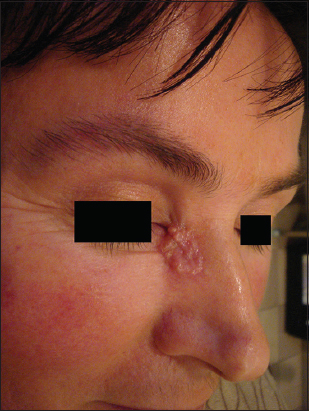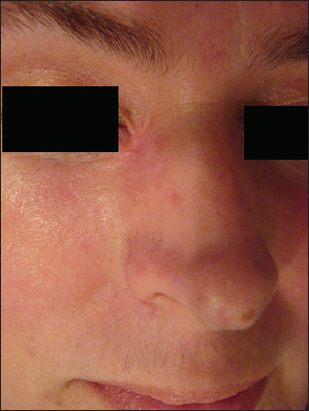A rare case of solitary trichoepithelioma treated with carbon dioxide laser
Katarzyna Borowska1,2, Adam Borzęcki3, Anna Szponar-Bojda3, Magdalena Raszewska-Famielec3
1Medical Center CADERM, Marszalkowska, Warsaw, Poland, 2Department of Histology and Embryology with Experimental Cytology Unit, Medical University of Lublin, Radziwiłowska, Lublin, Poland, 3Medical Center MED-LASER, Młyńska, Lublin, Poland
ABSTRACT
Trichoepithelioma (TE) is a benign skin neoplasm derived from the hair follicle. It is commonly located on the face and hairy skin. We report a rare and interesting case of a solitary trichoepithelioma (sTE) treated with a carbon dioxide laser. This report shows a positive therapeutic effect of a carbon dioxide laser on a patient with sTE located on the medial angle of the eye region. The carbon dioxide laser may be one of the therapeutic options in the case of sTE.
Key words: Solitary trichoepithelioma, Benign skin neoplasm, Carbon dioxide laser
Abbreviations: TE: Trichoepithelioma; sTE: Solitary trichoepithelioma; BCC: Basal cell carcinoma
INTRODUCTION
Trichoepithelioma (TE) is a benign skin neoplasm derived from the hair follicle. It is commonly located on the face and hairy skin. Malignant transformation is quite rare. TE affects adults and more frequently women. The most common presentations are noted in the 4th decade [1]. There are three variants of TE: solitary TE, multiple TE and desmoplastic TE [2–4]. The solitary TE is non-familial. The multiple TE is familial. The gene for the development of familial trichoepithelioma encodes of chromosome 9 [5]. We report a rare and interesting case of solitary trichoepithelioma (sTE) treated with carbon dioxide laser.
CASE REPORT
We present the case of a 47-year-old female patient, who was hospitalized in January 2009, for the presence of a skin tumor, 2 cm in diameter, brownish color, asymptomatic, located on the medial angle of the eye region (Fig. 1). The patient had past surgical history. The tumor appeared two years ago and it was gradually increasing in size. The patient was treated by surgery. Twice she had undergone ineffective surgical excisions (March 2007 and September 2008). A biopsy initially found nodular basal cell carcinoma (BCC).
There was no significant family history. The patient’s medical history included hypertension. Systemic examination and a general physical revealed no abnormality. Results of a routine laboratory studies were normal. During hospitalization, we performed a tumor biopsy. The histopathological examination, using Hematoxylin and Eosin (H+E)-stained paraffin cross-sections, showed microscopic structure of trichoepithelioma (Fig. 2). According to medical history, clinical features and histopathologic findings, a diagnosis of solitary trichoepithelioma (sTE) was made. We decided to avoid surgical procedures. The patient was treated with 10,600 – nm carbon dioxide laser CO2 excision. We performed two procedures with 3 weeks interval. Pretreatment anesthesia of 1% lidocaine was used. The tolerance of the treatment was very good with a total absence of clinical adverse events (Fig. 3). This complete remission was maintained after 7 years of follow-up.

Prior to the study, patient gave written consent to the examination and biopsy after having been informed about the procedure.
DISCUSSION
Trichoepithelioma (TE) was first described by Brooke as epithelioma adenoides cysticum, in 1892 [6]. Differential diagnosis for TE includes BCC. It is important to accurately differentiate between the two neoplasms. In certain cases, it may be difficult to clinically distinguish TE and BCC, particularly solitary trichoepithelioma (sTE). The distinction between BCC and TE on a histopathological basis is also quite difficult. BCC is the most prevalent cutaneous tumor. In contrast to BCC, TE is a benign tumor with clear follicular differentiation. This case highlights the importance of recognizing the solitary trichoepithelioma. The carbon dioxide laser is the most versatile laser used in the treatment of cutaneous tumors. The carbon dioxide laser constitutes an alternative to surgery in the treatment of large solitary nasal tip trichoepithelioma [7] and multiple trichoepithelioma [8,9]. This report shows a positive therapeutic effect of carbon dioxide laser on a patient with solitary trichoepithelioma located on the medial angle of eye region. Treatment option for patients with TE is treatment with carbon dioxide laser. It gives excellent cosmetic result and a high degree of satisfaction among treated patients. The carbon dioxide laser may be one of the therapeutic options in the case of solitary trichoepithelioma.
Consent
The examination of the patient was conducted according to the Declaration of Helsinki principles.
REFERENCES
1. Simpson W, Garner A, Collin JR, Benign hair-follicle derived tumours in the differential diagnosis of basal-cell carcinoma of the eyelids: a clinicopathological comparisonBr J Ophthalmol 1989; 73: 347-53.
2. Sanaa K, Zahra MF, A rare case of sporadic multiple trichoepitheliomasPan Afr Med J 2015; 21: 19-
3. Wang Q, Ghimire D, Wang J, Luo S, Li Z, Wang H, Desmoplastic trichoepithelioma: A clinicopathological study of three cases and a review of the literatureOncol Lett 2015; 10: 2468-76.
4. Stoica LE, Dascălu RC, Pătrałşcu V, Ciurea RN, Brăniłşteanu DE, Georgescu DM, Solitary trichoepithelioma: clinical, dermatoscopic and histopathological findingsRom J Morphol Embryol 2015; 56: 2 Suppl827-32.
5. Blake PW, Toro JR, Update of cylindromatosis gene (CYLD) mutations in Brooke–Spiegler syndrome: novel insights into the role of deubiquitination in cell signalingHum Mutat 2009; 30: 1025-36.
6. Anderson DE, Howell JB, Epithelioma adenoides cysticum: genetic updateBr J Dermatol 1976; 95: 225-32.
7. Yong AA, Goh CL, Successful treatment of a large solitary nasal tip trichoepithelioma using the 10,600-nm carbon dioxide laserDermatol Surg 2015; 41: 528-30.
8. Sawchuk Heald PW, CO2 laser treatment of trichoepithelioma with focused and defocused beamJ Dermatol Surg Oncol 1984; 10: 905-7.
9. Wheeland RG, Bailin PL, Kronberg E, Carbon dioxide (CO2) laser vaporization for the treatment of multiple trichoepitheliomaJ Dermatol Surg Oncol 1984; 10: 470-5.
Notes
Source of Support: Nil,
Conflict of Interest: None declared.


Comments are closed.